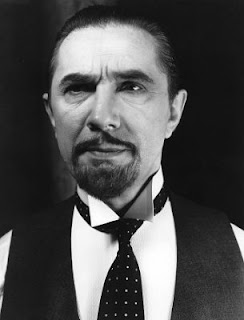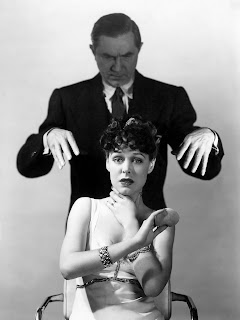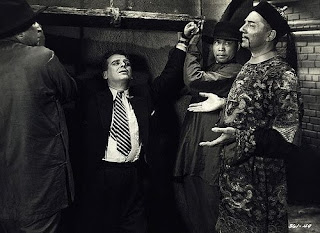Starring: Bela Lugosi, Clarence Muse, John McGuire, and Polly Ann Young
Director: Joseph H. Lewis
Rating: Four of Ten Stars
Charles Kessler (Lugosi) is a widely admired man who, known only to his faithful manservant Evans (Muse) and his daughter Virginia (Young) suffers minor bouts with insanity during which he thinks he is still living with his beloved wife, who vanished years ago. However, Kessler's insanity is far deeper and far deadlier than anyone imagines; his wife seemingly appears outside his window at night, and the sight of her sends him into a trance during which he committs horrendous strangulation murders. When Virginia's fiance (McGuire) is executed for one of the murders, his twin brother Paul (also McGuire) arrives in town intent on finding the true killer.

"The Invisible Ghost" is another one of those films where I can see lots of potential that buried under a badly written script. The idea of a decent man so filled with grief and rage that he goes into murderous trances is pretty neat, but in this case the question of exactly how crazy Kessler is undermind within the first ten minutes of the film. (There's a "big revelation" that should have been saved for much later on.) Further, the dialogue (and its delivery) feels more suitable for a stage play than a movie... and it's delivered by actors whose performances mostly leave a lot to be desired.
The two exceptions to my negative comments about the actors are Clarence Muse and Bela Lugosi.
In the case of Muse, he plays Kessler's butler and manservant, but he projects an intelligence, dignity, and sensitivity that is lacking in just about every other character in the film; he's also the one actor who never comes across as unintentionally funny in the film... his laugh lines are true laugh lines, and they're delivered with excellent timing.
Lugosi also gives an engaging performance. Although the man seemed to lack the ability to pick decent projects to perform in, he often managed to make the most of the roles he did. In this case, he shows his acting ability by going through several emotions, and even completely transforming himself by doing nothing but changing his facial expressions. On the downside of his performance in "The Invisible Ghost", Lugosi is unintentionally HILARIOUS when Kessler enters his murderous trances. It takes some of the horror and tragedy away from the story when giggling viewers are trying to decide what Kessler resembles most in his murderous state: Kharis the Mummy without his bandages, or a spastic retard shuffling home after riding the short bus.
One strong aspect of the film that I must mention is that it is beautifully lit. The technical crew who worked on it really knew their stuff--the many candle-lit scenes are very well-handled with spotlights that properly follow the actors carrying the candleholders, and lighting is used consistently with great effect to underscore the drama and tension. Further, there's some very creative camerawork on display. (On the downside, the drama and tension is undermind by a truly awful score and the aforementioned bad acting.)
I think "The Invisible Ghost" is worth watching for Muse and Lugosi's performances, but the bad definately outweighs the good.











